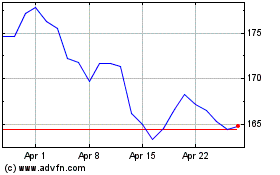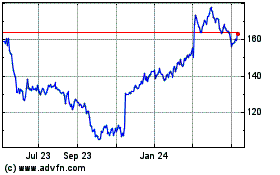CVS Health's Results Top Views--2nd Update
May 03 2016 - 12:35PM
Dow Jones News
By Paul Ziobro and Lisa Beilfuss
CVS Health Corp.'s first-quarter sales surged, helped by more
prescription claims and specialty drug sales at its
pharmacy-benefits business, and added revenue from recent
acquisitions on its drugstore side.
Its pharmacy-service division, which includes the specialty
pharmacy businesses and its pharmacy benefit manager, posted a 21%
increase in sales. The retail division logged growth of 19%,
primarily from the addition of roughly 1,600 Target Corp.
pharmacies that CVS now runs as well as the acquisition of Omnicare
Inc., which dispenses drugs to places like nursing homes. CVS
completed both deals in the last year.
Shares of the company rose 2.4% to $103.84 in midday
trading.
The Woonsocket, R.I.-based company is increasingly being driven
by its large pharmacy benefits management division that manages the
prescription drug coverage for health insurers. It is attracting
more clients by helping reduce overall drug spending at a time when
some manufacturers are pushing through significant price
increases.
CVS retail operations are benefiting from the new pharmacy
clients because some CVS plans offer patients lower prices when
prescriptions are filled in its pharmacies.
CVS argues its model is unique to the U.S. health-care market,
even as some rivals try to emulate it. Responding to a question on
Tuesday's earnings call about potential competition from a
partnership between the drugstore chain Walgreens Boots Alliance
Inc. and UnitedHealthcare Inc.'s pharmacy benefit business, Chief
Executive Larry Merlo said that this isn't the first time that
others have tried to peddle a product similar to its own.
"We're still the only ones with a fully integrated product," Mr.
Merlo said.
Existing CVS pharmacies performed well in the quarter. Overall
same-store sales rose 4.2%, with the metric up 5.5% in the pharmacy
business, driven by a 5.9% increase in prescription volumes.
CVS' front-of-store business posted much slower growth, with
same-store sales up just 0.7% after a 6.1% decline in the first
quarter of 2015. CVS is focusing on squeezing more profits out of
its stores by increasing sales of private-label items and expanding
its selection of beauty products.
With the front-end business now just 11% of overall CVS sales,
Mr. Merlo said CVS doesn't need to chase after lower-margin sales
like food or general merchandise and can instead wield that part of
the business to persuade shoppers to get their prescriptions filled
there.
"It really affords us the opportunity to think about the front
store in a very differentiated way," he said.
Overall, CVS reported a profit of $1.15 billion, down from $1.22
billion, as expenses grew faster than sales. Revenue rose 19% to
$43.22 billion. CVS forecast second-quarter earnings to come in
below analysts' estimates, but reiterated its outlook for the
year.
Write to Paul Ziobro at Paul.Ziobro@wsj.com and Lisa Beilfuss at
lisa.beilfuss@wsj.com
(END) Dow Jones Newswires
May 03, 2016 12:20 ET (16:20 GMT)
Copyright (c) 2016 Dow Jones & Company, Inc.
Target (NYSE:TGT)
Historical Stock Chart
From Mar 2024 to Apr 2024

Target (NYSE:TGT)
Historical Stock Chart
From Apr 2023 to Apr 2024
